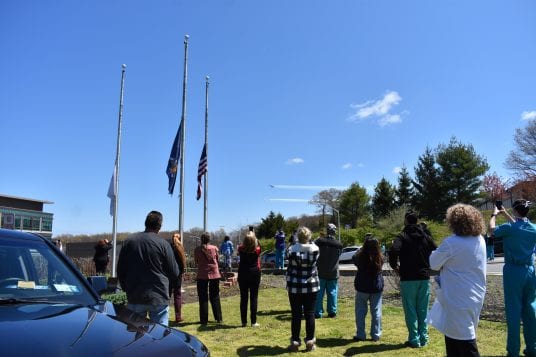Even as the emergency health care community is due for a break after an intense surge in patients who had COVID-19 finally subsides, hospitals are seeing an increase in demand for surgeries and procedures residents had put off amid the crisis.
About 10 days ago, Stony Brook University Hospital saw a rise in admissions that were unrelated to COVID-19, said Dr. Todd Griffin, the President of Medical Staff and Chair of the Department of Obstetrics, Gynecology and Reproductive Medicine.
Indeed, in the last few days, the non-COVID admissions have been higher than the COVID-driven admissions, Griffin said.
“Patients were staying at home so long” during the pandemic that some of them “had to go into the emergency room,” Griffin said.
Stony Brook had been at pandemic level D during the worst of the crisis and is now getting ready to transition to Pandemic level C, which will allow them to operate on more semi-urgent patients.
These patients either have chronic pain that needs surgical remedies, cancers that are low grade but where waiting more than 30 days could exacerbate the condition, spinal cases that, if left untreated, could lead to more permanent disabilities, or cardiac cases.
“We’re really looking at starting up semi-urgent cases first, then we’ll look at the elective cases” some time later, Griffin said.
A medical team is looking at these types of decisions, trying to determine what falls into the semi-urgent arena and what becomes more of an elective procedure.
Up until recently, the ambulatory surgery center had been acting as an Intensive Care Unit. The hospital is thoroughly cleaning that area to make sure it’s safe for reentry for the general patient population, Griffin said. They are also assessing whether they have the staff to address medical issues that extend beyond helping people battling the virus.
“We are still far from a return to business as usual,” the medical staff president said.
Stony Brook is making sure it has enough personal protective equipment. One of the challenges in preparing hospital rooms for future surgeries is that the material used to make the drapes is the same as the material for surgical masks and gowns.
“A lot of that material was diverted,” Griffin said. The hospital wants to make sure it has enough drapes to meet the medical need.
Even during the pandemic, Stony Brook has still been conducting about 10 to 15 procedures per day, which is well below the 70 to 80 patients who typically received treatment.
The individual departments have remained in touch with patients throughout the coronavirus outbreak.
“Our outpatient offices have still been open,” Griffin said.
Indeed, separate from responses to COVID-19, some areas of the hospital have become even busier, including obstetrics and gynecology.
Over the last three or four weeks, the hospital has received about 80 to 100 transfer patients, which is considerably higher than the five to 10 it receives in a typical week.
Some of those patients are residents of New York City and came to Stony Brook because hospitals in other regions had stopped allowing a support person during delivery.
Additionally, Stony Brook has single bedded units in its maternity ward, which means mothers have their own room throughout the process.
“We were trying to have as normal an experience as we can in a pandemic,” Griffin said. “I am so proud of the staff and nurses during this difficult time. They created the best experience for patients possible.”
Even with the hospital scheduling some additional surgeries in the weeks ahead, however, Stony Brook will follow Gov. Andrew Cuomo’s (D) guidance, remaining at or below 70 percent capacity in the event of another surge in demand from COVID-19.
Griffin is concerned that he will “see a second surge during the summer,” which planners are keeping in the “backs of their mind” as they add more patients to the surgery schedule.
Additionally, the medical community has spoken broadly about the combination in the fall or winter of a second wave of coronavirus at the same time as rising infections from the flu.
As the hospital prepares for more surgery patients, they will continue with procedures that protect patients and hospital staff, which includes wearing masks and more rigorous and frequent hand washing.
“Patients need to understand that if they come to Stony Brook Medicine, they are coming to a safe environment,” Griffin said. Griffin suggested that “coming to the hospital is still safer than going to the supermarket.”
Update: This article has been updated to indicate that the number of OB transfers over the last three to four weeks has been a total of 80 to 100, rather than 100 per week over that same time period. It also indicates that Stony Brook is considering whether the hospital can test visitors and how that would be done and that it is getting ready to transition to Pandemic Level C.




































































